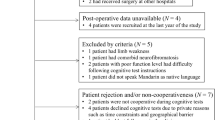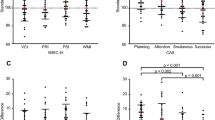Abstract
Objects
The aim of this study was to clarify predictors for poor intellectual outcome in pediatric moyamoya disease.
Methods
Fifty-two pediatric patients were included. Clinical diagnosis was transient ischemic attacks (TIA) in 35 and completed stroke in 17. Ten patients underwent indirect synangiosis through “small craniotomy,” whereas the other 42 underwent superficial temporal artery (STA)–middle cerebral artery (MCA) anastomosis and indirect synangiosis through “large craniotomy.” Full-scale IQ (FSIQ) was measured using the Wechsler intelligence scale for children (WISC) after surgery. Multivariate logistic regression models were applied to test the effect of clinical factors on intellectual outcome.
Results and conclusion
Eight patients revealed mentally impaired status (FSIQ<70). Multivariate analysis revealed that completed stroke and “small craniotomy” surgery were significantly associated with poor intellectual outcome. Odds ratios of each factor were 33.4 (95% CI, 2.4–474) and 19.6 (95% CI, 1.8–215) respectively. Early diagnosis and the revascularization procedure over as wide an area as possible may be essential to improve their intellectual outcome.


Similar content being viewed by others
References
Filley CM (2000) Clinical neurology and executive dysfunction. Semin Speech Lang 21:95–108
Fukui M (1997) Current state of study on moyamoya disease in Japan. Surg Neurol 47:138–143
Fukuyama Y, Umezu R (1985) Clinical and cerebral angiographic evolutions of idiopathic progressive occlusive disease of the circle of Willis (“moyamoya” disease) in children. Brain Dev 7:21–37
Houkin K, Aoki T, Takahashi A, Abe H (1994) Diagnosis of moyamoya disease with magnetic resonance angiography. Stroke 25:2159–2164
Houkin K, Kamiyama H, Takahashi A, Kuroda S, Abe H (1997) Combined revascularization surgery for childhood moyamoya disease: STA–MCA and encephalo-duro-arterio-myo-synangiosis. Childs Nerv Syst 13:24–29
Houkin K, Kuroda S, Ishikawa T, Abe H (2000) Neovascularization (angiogenesis) after revascularization in moyamoya disease. Which technique is most useful for moyamoya disease? Acta Neurochir (Wien) 142:269–276
Ikezaki K, Matsushima T, Kuwabara Y, Suzuki SO, Nomura T, Fukui M (1994) Cerebral circulation and oxygen metabolism in childhood moyamoya disease: a perioperative positron emission tomography study. J Neurosurg 81:843–850
Imaizumi T, Hayashi K, Saito K, Osawa M, Fukuyama Y (1998) Long-term outcomes of pediatric moyamoya disease monitored to adulthood. Pediatr Neurol 18:321–325
Imaizumi C, Imaizumi T, Osawa M, Fukuyama Y, Takeshita M (1999) Serial intelligence test scores in pediatric moyamoya disease. Neuropediatrics 30:294–299
Ishikawa T, Houkin K, Kamiyama H, Abe H (1997) Effects of surgical revascularization on outcome of patients with pediatric moyamoya disease. Stroke 28:1170–1173
Isobe M, Kuroda S, Kamiyama H, Abe H, Mitumori K (1992) Cerebral blood flow reactivity to hyperventilation in children with spontaneous occlusion of the circle of willis (moyamoya disease). No Shinkei Geka 20:399–407
Karasawa J, Touho H, Ohnishi H, Miyamoto S, Kikuchi H (1992) Long-term follow-up study after extracranial–intracranial bypass surgery for anterior circulation ischemia in childhood moyamoya disease. J Neurosurg 77:84–89
Kuroda S, Kamiyama H, Abe H, Yamauchi T, Kohama Y, Houkin K, Mitsumori K (1993) Cerebral blood flow in children with spontaneous occlusion of the circle of Willis (moyamoya disease): comparison with healthy children and evaluation of annual changes. Neurol Med Chir (Tokyo) 33:434–438
Kuroda S, Houkin K, Kamiyama H, Abe H, Mitsumori K (1995) Regional cerebral hemodynamics in childhood moyamoya disease. Childs Nerv Syst 11:584–590
Kuroda S, Houkin K, Kamiyama H, Mitsumori K, Iwasaki Y, Abe H (2001) Long-term prognosis of medically treated patients with internal carotid or middle cerebral artery occlusion: can acetazolamide test predict it? Stroke 32:2110–2116
Kurokawa T, Tomita S, Ueda K, Narazaki O, Hanai T, Hasuo K, Matsushima T, Kitamura K (1985) Prognosis of occlusive disease of the circle of Willis (moyamoya disease) in children. Pediatr Neurol 1:274–277
Matsushima Y, Aoyagi M, Masaoka H, Suzuki R, Ohno K (1990) Mental outcome following encephaloduroarteriosynangiosis in children with moyamoya disease with the onset earlier than 5 years of age. Childs Nerv Syst 6:440–443
Matsushima T, Inoue T, Suzuki SO, Fujii K, Fukui M, Hasuo K (1992) Surgical treatment of moyamoya disease in pediatric patients—comparison between the results of indirect and direct revascularization procedures. Neurosurgery 31:401–405
Matsushima Y, Aoyagi M, Nariai T, Takada Y, Hirakawa K (1997) Long-term intelligence outcome of post-encephalo-duro-arterio-synangiosis childhood moyamoya patients. Clin Neurol Neurosurg 99 [Suppl 2]:S147–S150
Miyamoto S, Akiyama M, Nagata I, Karasawa J, Nozaki K, Hashimoto N, Kikuchi H (1998) Long-term outcome after STA–MCA anastomosis for moyamoya disease. Neurosurg Focus 5:1–4
Ogawa A, Yoshimoto T, Suzuki J, Sakurai Y (1990) Cerebral blood flow in moyamoya disease. Part 1. Correlation with age and regional distribution. Acta Neurochir (Wien) 105:30–34
Sato H, Sato N, Tamaki N, Matsumoto S (1990) Chronic low-perfusion state in children with moyamoya disease following revascularization. Childs Nerv Syst 6:166–171
Suzuki J, Takaku A (1969) Cerebrovascular “moyamoya” disease. Disease showing abnormal net-like vessels in base of brain. Arch Neurol 20:288–299
Takahashi A, Kamiyama H, Houkin K, Abe H (1995) Surgical treatment of childhood moyamoya disease—comparison of reconstructive surgery centered on the frontal region and the parietal region. Neurol Med Chir (Tokyo) 35:231–237
Touho H, Karasawa J, Ohnishi H (1996) Preoperative and postoperative evaluation of cerebral perfusion and vasodilatory capacity with 99mTc-HMPAO SPECT and acetazolamide in childhood moyamoya disease. Stroke 27:282–289
Wakai K, Tamakoshi A, Ikezaki K, Fukui M, Kawamura T, Aoki R, Kojima M, Lin Y, Ohno Y (1997) Epidemiological features of moyamoya disease in Japan: findings from a nationwide survey. Clin Neurol Neurosurg 99 [Suppl 2]:S1–S5
Wechsler D (1998) Manual for the Wechsler intelligence scale for children, 3rd edn (Japanese version). The Psychological Corporation, San Antonio
Author information
Authors and Affiliations
Corresponding author
Rights and permissions
About this article
Cite this article
Kuroda, S., Houkin, K., Ishikawa, T. et al. Determinants of intellectual outcome after surgical revascularization in pediatric moyamoya disease: a multivariate analysis. Childs Nerv Syst 20, 302–308 (2004). https://doi.org/10.1007/s00381-004-0924-4
Received:
Published:
Issue Date:
DOI: https://doi.org/10.1007/s00381-004-0924-4




